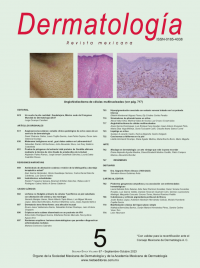Multinucleated cell angiohistiocytoma.
Dermatol Rev Mex. 2023; 67 (5): 717-722. https://doi.org/10.24245/drm/bmu.v67i5.9141
Anais García Domínguez,1 Luis Enrique Cano Aguilar,3 Israel Antonio Esquivel Pinto,2 María Elisa Vega Memije,4 Sonia Toussaint Caire,4 Claudia Ileana Saenz Corral4
1 Dermatóloga. Consulta privada. Médica Árbol de la Vida, Metepec, Estado de México.
2 Dermatólogo. Consulta privada. Clínica Dermatlan, Ciudad de México, México
3 Residente de Dermatología.
4 Adscrita a la División de Dermatología.
Hospital General Dr. Manuel Gea González, Ciudad de México, México.
Resumen
ANTECEDENTES: El angiohistiocitoma de células multinucleadas es un tumor fibrohistiocítico que afecta frecuentemente a mujeres mayores de 40 años. En términos clínicos, se manifiesta como una dermatosis que afecta las extremidades superiores, inferiores y la cara, caracterizada por neoformaciones planas, nodulares o papulares, color rosado-violáceo, de 3 a 10 mm, asintomáticas. Los hallazgos clínicos son inespecíficos, por lo que realizar un estudio histopatológico es de suma importancia para establecer el diagnóstico. Por lo general los pacientes tienen excelente evolución.
CASO CLÍNICO: Paciente femenina de 35 años, que acudió a consulta por padecer una dermatosis diseminada a la mejilla derecha, el hombro derecho y los brazos, bilateral y asimétrica, caracterizada por máculas color violáceo, irregulares, de límites definidos y de 0.4 a 0.7 cm de diámetro. En la imagen dermatoscópica se observaron áreas ligeramente eritematosas, difusas y con parches blanquecinos en la periferia. En la biopsia por escisión se observaron múltiples vasos sanguíneos y capilares de neoformación, así como abundantes células grandes, de aspecto fusiforme, multinucleadas, localizadas en la dermis papilar y reticular. En la inmunomarcación se observó positividad para CD34, factor XIIIa, vimentina y CD117, sugerentes de angiohistiocitoma de células multinucleadas.
CONCLUSIONES: El angiohistiocitoma de células multinucleadas es una afección poco frecuente de comportamiento benigno. Los datos histológicos, de inmunomarcación y la evolución clínica habitual de estas lesiones indican que es un proceso reactivo y que puede optarse por un manejo expectante de manera segura.
PALABRAS CLAVE: Tumor fibrohistiocítico; biopsia de piel; vasos sanguíneos; capilares.
Abstract
BACKGROUND: Multinucleated cell angiohistiocytoma is a fibrohistiocytic tumor that frequently affects women over 40 years of age. Clinically, it presents as flat, nodular or papular neoformations that affect the upper and lower limbs and the face. The clinical findings are nonspecific, so performing a skin biopsy is of the utmost importance to establish the diagnosis based on histopathological data. Patients generally have an excellent evolution.
CLINICAL CASE: A 35-year-old female patient presented with bilateral and asymmetric irregular, purplish-colored macules that affected the right cheek, right shoulder and arms. In the dermatoscopic image, diffuse and slightly erythematous areas with whitish patches were observed in the periphery. In the excisional biopsy multiple newly formed blood vessels and capillaries were observed, as well as abundant, large, fusiform, multinucleated cells located in the papillary and reticular dermis. In immunostaining, CD34, factor XIIIa, vimentin and CD117 were positive.
CONCLUSIONS: Multinucleated cell angiohistiocytoma is a rare entity with benign behavior. Histological data, immunostaining and the usual clinical evolution of these lesions indicate that it is a reactive process and an expectant management can be safely chosen.
KEYWORDS: Fibrohistiocytic tumor; Skin biopsy; Blood vessels; Capillaries.
Recibido: agosto 2022
Aceptado: agosto 2022
Este artículo debe citarse como: García-Domínguez A, Cano-Aguilar LE, Esquivel-Pinto IA, Vega-Memije ME, Toussaint-Caire S, Saenz-Corral CI. Angiohistiocitoma de células multinucleadas. Dermatol Rev Mex 2023; 67 (5): 717-722.

